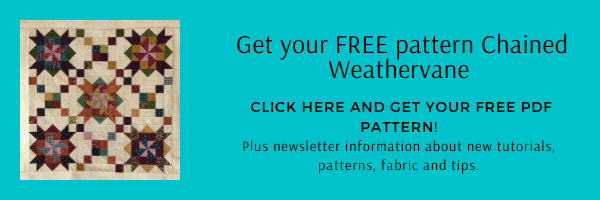How to Make a Chain Variation Quilt Block
Today let's look at how to sew this Chain variation block. It makes a great alternating block. The original design was for a 10" block but I wanted a 12" block so I added to it. While the block is easy (all squares and rectangles), there are small pieces to work with! Let's get started.

Fabric Requirements for a 12" Finished Chain Variation Quilt Block:
- Light/White: 4 - 3.5" x 6.5" rectangles, 4 - 2.5" squares, and 8 - 1.5" x 2.5" rectangles (the picture is wrong - oops!)
- Medium/Yellow: 3 - 3" squares, 2 - 2.5" squares, and 2 - 1.5" squares
- Medium/Green: 3 - 3" squares, 2 - 2.5" squares, and 2 - 1.5" squares

Sewing Directions:
Four Patch Units:
Step 1:
Mark a center line parallel to the edge on the back of the three Medium/Yellow 3" squares as shown in the picture below.
Since I'm only making one block for this tutorial, I decided to make my Four Patches with this method. You could cut 1.5" squares and put them together that way. If I were making multiple blocks, I would use the strip set method for making them. You can find a tutorial with several methods at https://fabric406.com/blogs/fabric406-blog/how-to-sew-a-basic-four-patch-quilt-block

Step 2:
Match up one of the Medium/Yellow 3" squares with a Dark/Green 3" square, right sides together. Sew 1/4" (or a little less) on each side of the marked line (top left image). Cut along the marked line (top right image). Press the seam allowance toward the Dark/Green fabric (bottom images).

Step 3:
Mark a center line perpendicular to the seam allowance on the back of a Step 2 unit. Pair it up with another Step 2 unit, rotating it so the colors are opposite each other and the seam allowances nest together. Sew 1/4" (or a bit less) on both sides of the marked line (top left image). Cut along the marked line (top right image). Open up and press the seam allowance (bottom images). You can see from the photo below that I've used the twirl/tweak/furl method of pressing.

Step 4:
Repeat Steps 2 and 3 for a total of six Four Patch units. You only need five of these units for each block. The extra one can be used for another block.

Corner Units:
Step 5:
Sew a Light/White 1.5" x 2.5" rectangle to a Step 4 unit and press the seam allowance toward the white fabric as shown in the picture below. Repeat for a total of four units.

Step 6:
Sew a Dark/Green 1.5" square to one end of a Light/White 1.5" x 2.5" rectangles and press the seam allowance toward the white fabric (top images). Repeat to make two units.
Do the same substituting the Medium/Yellow 1.5" squares for the green squares (bottom images).

Step 7:
Match up a Step 6 white/green unit with a Step 5 unit and sew together. Make sure your green squares line up diagonally! Press the seam allowance toward the white/green rectangle as shown in the picture below. Repeat for a total of two units.

Step 8:
Repeat Step 7 using a white/yellow Step 6 unit and making sure the Medium/Yellow squares line up diagonally.

Center Unit:
Step 9:
Lay out the remaining Four Patch unit, four Light/White 2.5" squares, two Medium/Yellow 2.5" squares, and two Dark/Green 2.5" squares as shown below. This is sewn together like a basic Nine Patch block.

Step 10:
Sew the patches into three rows as shown below.

Step 11:
Press the seam allowances toward the Light/White fabric as shown.

Step 12:
Sew the three rows together as shown below. That center Four Patch is a little wonky!

Step 13:
Press the seam allowances away from the center of the unit as shown in the picture below.

Putting It All Together:
Step 14:
Lay out the Center unit, the Corner units, and the Light/White 3.5" x 6.5" rectangles as shown in the picture below. Make sure the Medium/Yellow squares and the Dark/Green squares make diagonal lines in the block.

Step 15:
Sew the units into three rows just like an uneven Nine Patch block.

Step 16:
Press the seam allowances toward the Light/White rectangles as shown in the picture below.

Step 17:
Sew the three rows together, and...

Step 18:
Press the seam allowances. I've pressed toward the center of the block but you can press however you wish. All Done!

Layout Options:
Here's what the block could look like when put in a quilt as an alternating block.

Here's an example using the same block throughout but using a different coloring in alternating blocks.

Conclusion:
I really like this Chain block. I was looking for a quick block but neglected to take into account the little pieces! However, working with small pieces really improves one's piecing accuracy! Plus, when you later make a block with larger pieces, it seems so much easier - lol!
I hope you've enjoyed this Chain Variation quilt block tutorial. If you liked this post and want to see more quilting tutorials like this, simply click here to sign up for my newsletter and also receive a free PDF.
Happy Quilting!
Elaine
P.S. To figure out yardage for a quilt, check out this post: https://fabric406.com/blogs/fabric406-blog/how-much-fabric-do-i-need
